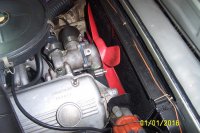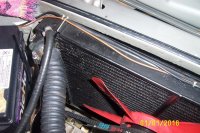Our 1970 2800CS water pump just died, so out is the radiator and off the old pump. With everything off I realized that years ago (at least 15 or so) I or the previous owner must have eliminated the friction fan coupling and bolted the red 5 blade fan directly to the water pump.
Living in southwest Florida we really have not seen any overheating problems. We do use the R12 AC in the summer occasionally and the aux fan comes on with the compressor. Also we have a way to manually turn on the electric aux fan even if the AC is off, but really do not have the need to do so.
Car is originally a 4 speed converted to a five speed. The radiator is from an automatic CS as I believe they are a little bigger and help in cooling. True?
So the question is, what is the down side to having the fan bolted directly to the water pump? Noise?, Reduction in cooling?, additional wear on the water pump bearing?
Any comments? Anyone else done this and if so what is your experience?
Also as a discussion can someone explain why cars use either a friction or the later viscous couplings? What is the advantage? Older cars all used to have the fan directly bolted to the water pump.
Thanks in advance
jjs2800cs
Living in southwest Florida we really have not seen any overheating problems. We do use the R12 AC in the summer occasionally and the aux fan comes on with the compressor. Also we have a way to manually turn on the electric aux fan even if the AC is off, but really do not have the need to do so.
Car is originally a 4 speed converted to a five speed. The radiator is from an automatic CS as I believe they are a little bigger and help in cooling. True?
So the question is, what is the down side to having the fan bolted directly to the water pump? Noise?, Reduction in cooling?, additional wear on the water pump bearing?
Any comments? Anyone else done this and if so what is your experience?
Also as a discussion can someone explain why cars use either a friction or the later viscous couplings? What is the advantage? Older cars all used to have the fan directly bolted to the water pump.
Thanks in advance
jjs2800cs


